Can You to Flush Food in the Toilet?
Can You to Flush Food in the Toilet?
Blog Article
This great article down below about Flushing Food Down the Toilet? is exceedingly stimulating. Check it out for your own benefit and figure out what you think about it.

Introduction
Many people are often confronted with the predicament of what to do with food waste, specifically when it comes to leftovers or scraps. One usual concern that occurs is whether it's okay to purge food down the bathroom. In this short article, we'll look into the reasons people could take into consideration flushing food, the consequences of doing so, and alternate methods for appropriate disposal.
Reasons why individuals could think about purging food
Lack of understanding
Some people may not recognize the prospective harm brought on by flushing food down the toilet. They may erroneously believe that it's a safe technique.
Convenience
Flushing food down the commode might appear like a fast and very easy solution to throwing away undesirable scraps, specifically when there's no close-by trash can offered.
Negligence
Sometimes, individuals may simply pick to flush food out of large idleness, without taking into consideration the repercussions of their actions.
Consequences of flushing food down the toilet
Ecological effect
Food waste that ends up in rivers can add to contamination and damage aquatic environments. Furthermore, the water used to flush food can strain water resources.
Plumbing issues
Purging food can cause clogged pipelines and drains, triggering costly plumbing fixings and aggravations.
Kinds of food that must not be flushed
Coarse foods
Foods with coarse structures such as celery or corn husks can get tangled in pipelines and create clogs.
Starchy foods
Starchy foods like pasta and rice can absorb water and swell, causing obstructions in pipes.
Oils and fats
Greasy foods like bacon or cooking oils should never be flushed down the commode as they can strengthen and trigger clogs.
Proper disposal methods for food waste
Utilizing a garbage disposal
For homes furnished with waste disposal unit, food scraps can be ground up and purged through the pipes system. Nonetheless, not all foods are suitable for disposal in this fashion.
Recycling
Certain food packaging products can be reused, reducing waste and lessening environmental impact.
Composting
Composting is an environmentally friendly method to throw away food waste. Organic materials can be composted and used to enhance dirt for horticulture.
The value of appropriate waste administration
Minimizing environmental injury
Correct waste administration practices, such as composting and recycling, aid decrease pollution and preserve natural resources for future generations.
Shielding pipes systems
By avoiding the technique of flushing food down the commode, house owners can prevent expensive pipes fixings and keep the stability of their plumbing systems.
Verdict
To conclude, while it may be tempting to purge food down the commode for benefit, it is necessary to understand the possible effects of this action. By taking on appropriate waste management practices and throwing away food waste properly, individuals can contribute to healthier plumbing systems and a cleaner environment for all.
FLUSH FOOD DOWN THE TOILET?
FLUSHING FOOD CAN CAUSE BLOCKED DRAINS IN YOUR HOME
All of the plumbing fixtures in your home are connected to the same sewer pipe outside of your home. This outdoor sewer pipe is responsible for transporting all the wastewater from your home to the Council sewer mains. Even small pieces of food that go down the kitchen sink can cause problems for your sewer. It should therefore be obvious that flushing larger bits of food, such as meat, risks a clog in either the toilet itself or the sewer pipes. Flushing greasy food is even more problematic because oil coagulates when it cools, coating the interior lining of your pipes.
THE TOILET IS NOT A BIN
Food isn’t the only thing that people shouldn’t be flushing down the toilet. People use the toilet to dispose of all kinds of things such as tampons, makeup wipes, dental floss, kitty litter and even underwear. Water goes to great lengths to educate residents about the high costs and stress placed on wastewater treatment systems simply from people flushing the wrong stuff down the toilet. It costs taxpayers millions of dollars each year, and homeowners thousands in blocked drain repairs.
FLUSHING FOOD IS A WASTE OF WATER
Flushing food is a waste of our most precious resource - water. In June this year Level 1 water restrictions were introduced to protect water supply from drought conditions. Much of New South Wales continues to be affected by prolonged drought with recent figures revealing up to 97 per cent of the state remains in drought. Depending on whether you have a single or dual flush toilet, every single flush uses between five and 11 litres of water. In the current climate this is a huge amount of water to be wasting on flushing food that should be placed in the bin (or better yet, the compost).
https://www.jabplumbingsolutions.com.au/blog/can-you-flush-food-down-the-toilet

Do you like reading up on Flushing Food Down the Toilet?? Post a short review down below. We would be delighted to hear your reactions about this piece. Hoping to see you back again in the near future. Appreciated our blog entry? Please share it. Let someone else check it out. Thank you so much for your time spent reading it.
Book Now Report this page